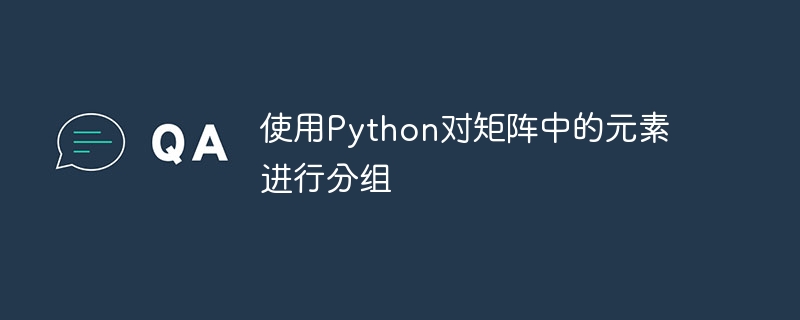使用Python对矩阵中的元素进行分组

矩阵广泛应用于各个领域,包括数学、物理和计算机科学。在某些情况下,我们需要根据某些标准对矩阵的元素进行分组。我们可以按行、列、值、条件等对矩阵的元素进行分组。在本文中,我们将了解如何使用 Python 对矩阵的元素进行分组。
创建矩阵
在深入研究分组方法之前,我们可以首先在 Python 中创建一个矩阵。我们可以使用 NumPy 库有效地处理矩阵。以下是我们如何使用 NumPy 创建矩阵:
示例
下面的代码创建一个 3x3 矩阵,其值范围为 1 到 9。
import numpy as np
# Creating a 3x3 matrix
matrix = np.array([[1, 2, 3],
[4, 5, 6],
[7, 8, 9]])
print(matrix)
输出
[[1 2 3] [4 5 6] [7 8 9]]
按行或列对元素进行分组
对矩阵中的元素进行分组的最简单方法是按行或列。我们可以使用 Python 中的索引轻松实现这一点。
按行分组
要按行对元素进行分组,我们可以使用索引符号矩阵[row_index]。例如,要对矩阵中的第二行进行分组,我们可以使用matrix[1]。
语法
matrix[row_index]
这里,矩阵是指我们要从中提取特定行的矩阵或数组的名称。 row_index 表示我们要访问的行的索引。在Python中,索引从0开始,因此第一行称为0,第二行称为1,依此类推。
示例
import numpy as np
# Creating a 3x3 matrix
matrix = np.array([[1, 2, 3],
[4, 5, 6],
[7, 8, 9]])
row_index = 1
grouped_row = matrix[row_index]
print(grouped_row)
输出
[4 5 6]
按列分组
要按列对元素进行分组,我们可以使用索引符号矩阵[:,column_index]。例如,要将矩阵中的第三列分组,我们可以使用matrix[:, 2]。
示例
import numpy as np
# Creating a 3x3 matrix
matrix = np.array([[1, 2, 3],
[4, 5, 6],
[7, 8, 9]])
column_index = 2
grouped_column = matrix[:, column_index]
print(grouped_column)
输出
[3 6 9]
按条件对元素进行分组
在许多情况下,我们需要根据某些标准而不是按行或列对元素进行分组。我们将探索两种方法来实现这一目标:按值分组和按条件分组。
按值分组
要根据值对矩阵中的元素进行分组,我们可以使用 NumPy 的 where 函数。按值对矩阵中的元素进行分组使我们能够轻松识别和提取感兴趣的特定元素。当我们需要分析或操作矩阵中具有某些值的元素时,此方法特别有用。
语法
np.where(condition[, x, y])
Here,the condition is the condition to be evaluated. It can be a boolean array or an expression that returns a boolean array. x (optional): The value(s) to be returned where the condition is True. It can be a scalar or an array−like object. y (optional): The value(s) to be returned where the condition is False. It can be a scalar or an array−like object.
示例
import numpy as np
# Creating a 3x3 matrix
matrix = np.array([[1, 2, 3],
[4, 5, 6],
[7, 8, 9]])
value = 2
grouped_elements = np.where(matrix == value)
print(grouped_elements)
输出
(array([0]), array([1]))
按条件分组
还可以使用 NumPy 的 where 函数根据特定条件对矩阵中的元素进行分组。让我们考虑一个示例,我们要将所有大于 5 的元素分组。
语法
np.where(condition[, x, y])
Here,the condition is the condition to be evaluated. It can be a boolean array or an expression that returns a boolean array. x (optional): The value(s) to be returned where the condition is True. It can be a scalar or an array−like object. y (optional): The value(s) to be returned where the condition is False. It can be a scalar or an array−like object.
示例
import numpy as np
# Creating a 3x3 matrix
matrix = np.array([[1, 2, 3],
[4, 5, 6],
[7, 8, 9]])
condition = matrix > 5
grouped_elements = np.where(condition)
print(grouped_elements)
输出
(array([1, 2, 2, 2]), array([2, 0, 1, 2]))
通过迭代对元素进行分组
对矩阵中的元素进行分组的另一种方法是迭代其行或列并收集所需的元素。这种方法使我们能够更灵活地对分组元素执行附加操作。
语法
list_name.append(element)
Here, the append() function is a list method used to add an element to the end of the list_name. It modifies the original list by adding the specified element as a new item.
示例
import numpy as np
# Creating a 3x3 matrix
matrix = np.array([[1, 2, 3],
[4, 5, 6],
[7, 8, 9]])
grouped_rows = []
for row in matrix:
grouped_rows.append(row)
print(grouped_rows)
输出
[array([1, 2, 3]), array([4, 5, 6]), array([7, 8, 9])]
结论
在本文中,我们讨论了如何使用 Python 内置函数对矩阵中的不同元素进行分组,我们首先使用 NumPy 库创建矩阵,然后讨论各种分组技术。我们介绍了按行和列进行分组,以及使用 NumPy 中的 where 函数按值和条件进行分组。
以上是使用Python对矩阵中的元素进行分组的详细内容。更多信息请关注PHP中文网其他相关文章!

热AI工具

Undresser.AI Undress
人工智能驱动的应用程序,用于创建逼真的裸体照片

AI Clothes Remover
用于从照片中去除衣服的在线人工智能工具。

Undress AI Tool
免费脱衣服图片

Clothoff.io
AI脱衣机

AI Hentai Generator
免费生成ai无尽的。

热门文章

热工具

记事本++7.3.1
好用且免费的代码编辑器

SublimeText3汉化版
中文版,非常好用

禅工作室 13.0.1
功能强大的PHP集成开发环境

Dreamweaver CS6
视觉化网页开发工具

SublimeText3 Mac版
神级代码编辑软件(SublimeText3)

热门话题
 mysql 是否要付费
Apr 08, 2025 pm 05:36 PM
mysql 是否要付费
Apr 08, 2025 pm 05:36 PM
MySQL 有免费的社区版和收费的企业版。社区版可免费使用和修改,但支持有限,适合稳定性要求不高、技术能力强的应用。企业版提供全面商业支持,适合需要稳定可靠、高性能数据库且愿意为支持买单的应用。选择版本时考虑的因素包括应用关键性、预算和技术技能。没有完美的选项,只有最合适的方案,需根据具体情况谨慎选择。
 mysql安装后怎么使用
Apr 08, 2025 am 11:48 AM
mysql安装后怎么使用
Apr 08, 2025 am 11:48 AM
文章介绍了MySQL数据库的上手操作。首先,需安装MySQL客户端,如MySQLWorkbench或命令行客户端。1.使用mysql-uroot-p命令连接服务器,并使用root账户密码登录;2.使用CREATEDATABASE创建数据库,USE选择数据库;3.使用CREATETABLE创建表,定义字段及数据类型;4.使用INSERTINTO插入数据,SELECT查询数据,UPDATE更新数据,DELETE删除数据。熟练掌握这些步骤,并学习处理常见问题和优化数据库性能,才能高效使用MySQL。
 mySQL下载完安装不了
Apr 08, 2025 am 11:24 AM
mySQL下载完安装不了
Apr 08, 2025 am 11:24 AM
MySQL安装失败的原因主要有:1.权限问题,需以管理员身份运行或使用sudo命令;2.依赖项缺失,需安装相关开发包;3.端口冲突,需关闭占用3306端口的程序或修改配置文件;4.安装包损坏,需重新下载并验证完整性;5.环境变量配置错误,需根据操作系统正确配置环境变量。解决这些问题,仔细检查每个步骤,就能顺利安装MySQL。
 mysql下载文件损坏无法安装的修复方案
Apr 08, 2025 am 11:21 AM
mysql下载文件损坏无法安装的修复方案
Apr 08, 2025 am 11:21 AM
MySQL下载文件损坏,咋整?哎,下载个MySQL都能遇到文件损坏,这年头真是不容易啊!这篇文章就来聊聊怎么解决这个问题,让大家少走弯路。读完之后,你不仅能修复损坏的MySQL安装包,还能对下载和安装过程有更深入的理解,避免以后再踩坑。先说说为啥下载文件会损坏这原因可多了去了,网络问题是罪魁祸首,下载过程中断、网络不稳定都可能导致文件损坏。还有就是下载源本身的问题,服务器文件本身就坏了,你下载下来当然也是坏的。另外,一些杀毒软件过度“热情”的扫描也可能造成文件损坏。诊断问题:确定文件是否真的损坏
 mysql安装后怎么优化数据库性能
Apr 08, 2025 am 11:36 AM
mysql安装后怎么优化数据库性能
Apr 08, 2025 am 11:36 AM
MySQL性能优化需从安装配置、索引及查询优化、监控与调优三个方面入手。1.安装后需根据服务器配置调整my.cnf文件,例如innodb_buffer_pool_size参数,并关闭query_cache_size;2.创建合适的索引,避免索引过多,并优化查询语句,例如使用EXPLAIN命令分析执行计划;3.利用MySQL自带监控工具(SHOWPROCESSLIST,SHOWSTATUS)监控数据库运行状况,定期备份和整理数据库。通过这些步骤,持续优化,才能提升MySQL数据库性能。
 mysql 需要互联网吗
Apr 08, 2025 pm 02:18 PM
mysql 需要互联网吗
Apr 08, 2025 pm 02:18 PM
MySQL 可在无需网络连接的情况下运行,进行基本的数据存储和管理。但是,对于与其他系统交互、远程访问或使用高级功能(如复制和集群)的情况,则需要网络连接。此外,安全措施(如防火墙)、性能优化(选择合适的网络连接)和数据备份对于连接到互联网的 MySQL 数据库至关重要。
 如何针对高负载应用程序优化 MySQL 性能?
Apr 08, 2025 pm 06:03 PM
如何针对高负载应用程序优化 MySQL 性能?
Apr 08, 2025 pm 06:03 PM
MySQL数据库性能优化指南在资源密集型应用中,MySQL数据库扮演着至关重要的角色,负责管理海量事务。然而,随着应用规模的扩大,数据库性能瓶颈往往成为制约因素。本文将探讨一系列行之有效的MySQL性能优化策略,确保您的应用在高负载下依然保持高效响应。我们将结合实际案例,深入讲解索引、查询优化、数据库设计以及缓存等关键技术。1.数据库架构设计优化合理的数据库架构是MySQL性能优化的基石。以下是一些核心原则:选择合适的数据类型选择最小的、符合需求的数据类型,既能节省存储空间,又能提升数据处理速度
 MySQL安装后服务无法启动的解决办法
Apr 08, 2025 am 11:18 AM
MySQL安装后服务无法启动的解决办法
Apr 08, 2025 am 11:18 AM
MySQL拒启动?别慌,咱来排查!很多朋友安装完MySQL后,发现服务死活启动不了,心里那个急啊!别急,这篇文章带你从容应对,揪出幕后黑手!读完后,你不仅能解决这个问题,还能提升对MySQL服务的理解,以及排查问题的思路,成为一名更强大的数据库管理员!MySQL服务启动失败,原因五花八门,从简单的配置错误到复杂的系统问题都有可能。咱们先从最常见的几个方面入手。基础知识:服务启动流程简述MySQL服务启动,简单来说,就是操作系统加载MySQL相关的文件,然后启动MySQL守护进程。这其中涉及到配置






